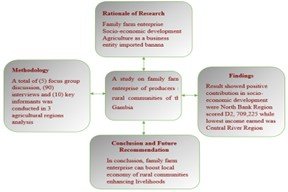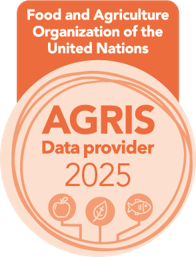A study on family farm-enterprise of producers in rural communities of the Gambia
Abstract
The agricultural systems of the Gambia entirely depend on rain-fed agriculture, and it propels economic growth. Agriculture's contribution to the Gambia's GDP is 22%. The Gambia's economy heavily depends on agriculture and provides 30–40% of the country's foreign exchange earnings. Family farm enterprise is a lucrative business, but limited research work has been done to determine its economic contributions in improving the livelihoods of producers. The problem statement of the research work is to identify knowledge gap, finance, and markets of family farm producers to enhance production capacity, yield and income. The objective identifies the contribution of family enterprise to the economy, and to address the challenges that affects profitability. The study applied a purposive sampling technique for qualitative and quantitative approaches. The methodology of data collection was focus group discussion, key informants’ interviews and review of secondary data from other research work. A total of (5) focus group discussions, (90) interviews and (10) key informants was conducted in 3 agricultural regions. The results showed female participates immensely in family farm production than male of 443 and 25 respectively. The result showed positive contribution in socio-economic development were North Bank Region scored D2, 709,225 while lowest income earned was Central River Region amounting to D279,700.00 respectively. In conclusion, family farm enterprises can boost local economy of rural communities enhancing livelihoods. Thus, recommend government to create easy access to finance, market and training on business management skills for the family members engaged in agriculture as a business entity.
Keywords:
Agriculture, Communities, Enterprise, Family farm, ProducersDownloads
References
Aljuwaiber, A. (2020) Entrepreneurship research in the Middle East and North Africa: trends, challenges, and sustainability issues. Journal of Entrepreneurship in Emerging Economies, 20, 731-748, https://doi.org/10.1108/JKM-12-2015-0494
Fieve, J. K. D., & Chrysostome, E. V. (2022). Credit Cooperative Lending Loans as Challenges and Opportunities for Women Entrepreneurship in Africa: Evidence from Ghana. Journal of African Business, https://doi.org/10.1080/15228916.2022.2078937
Baltazar, J. R., Fernandes, C. I., Ramadani, V., & Hughes, M. (2023). Family business succession and innovation: a systematic literature review. Review of Managerial Science, 1–24
Barry, I., & Rousselière, D. (2022). Do quality incentive payments improve cooperative performance? The case of small French agricultural cooperatives. Journal of Agricultural Economics, 73(3), 938-948. https://doi.org/10.1111/1477-9552.12475
Bernatovic, I., Gomezel, S. A., & Cerne, M. (2021). Mapping the knowledge-hiding field and its future prospects: a bibliometric co-citation, co-word, and coupling analysis. Journal of knowledge Management Research and Practice, 1–16.
Boers, B., & Henschel, T. Boers, B. and Henschel, T. (2022), “Turning around the family and the business? Examples of turn around strategies from Germany, Scotland, and Sweden”, The Nordic 71(2), 77-101.
Bunthan, T., Elena, G., & Nicola, S. (2020). Linking smallholder producers to high-value markets through vegetable producer cooperatives in Cambodia. https://doi.org/10.22434/IFAMR2020.0135
Crossman, A. (2020). Understanding Purposive Sampling. An Overview of the Methods and its application https://www.thoughtco.com/ purposive-sampling-3026727
Dlamini, B. P. Ferrer, S., & Ortmann, G. (2019). Factors affecting the choice of marketing outlet selection strategies by smallholder farmers in Swaziland. African Journal of Science, Technology, Innovation and Development 1(1): 1-9.
Edeoba, W. Edobor, R. Wiattb D, Maria I. & Marshall, C. (2020). Keeping the farm business in the family: the case of farm and non-farm family businesses in the Midwestern United States. 24, 6, https://doi.org/10.22434/IFAMR2020.0138
Eric, K. O., Gabriel, S., & Jessie, V. (2019). The effects of agricultural cooperatives on smallholder livelihoods and agricultural performance in Cambodia. Natural Resource Forum, 43(4), 218-229.
Ishak, S. Omar, A. R. C. Sum, S.M. Othman, A. S., & Jaafar, J. (2020). Smallholder agriculture cooperatives’ performance: What is in the minds of management? Journal of Cooperative. Organization and Management, 8(2), 100110. http://doi.org/10.1016/j.jcom.2020.100110
Macharia, J. Mishili, F., & Sumari, G. S. (2018). Participation of smallholder vegetable growers in high-value market chains in Arusha, Tanzania. International Journal of Scientific and Research Publications, 8(4), 371-380.
Nermin, B., & Eray, C. (2020). Determining of agricultural credit impact on agricultural production value in Turkey. Ciência Rural, Santa Maria, v.50:11, e20200003, 2020. https://doi.org/10.1590/0103-8478cr20200003
Ovharhe, O. J. (2019). Determinants of the socioeconomic profile of Fadama III Project beneficiaries in three States of Niger Delta Area of Nigeria. International Journal of Agricultural Science, 4, 29-34.
Taye, M. Degye, G., & Assefa, T. (2018). Determinants of outlet choices by smallholder onion farmers in Fogera district Amhara Region, Northwestern Ethiopia. Journal of Horticulture and Forestry, 10(3), 27-35.
Wiatt, R. D. Marshall, M. I. & Mussel man, R. (2019). Management and ownership transfer: the case of mid-western family businesses. Presented at the Small Business Institute Conference. February 14-16, 2019. Orlando, FL, USA, pp. 52-6814-16, 2019. Orlando, FL, USA, pp. 52-68.

Published
How to Cite
Issue
Section
Copyright (c) 2024 Agriculture and Environmental Science Academy

This work is licensed under a Creative Commons Attribution-NonCommercial 4.0 International License.

